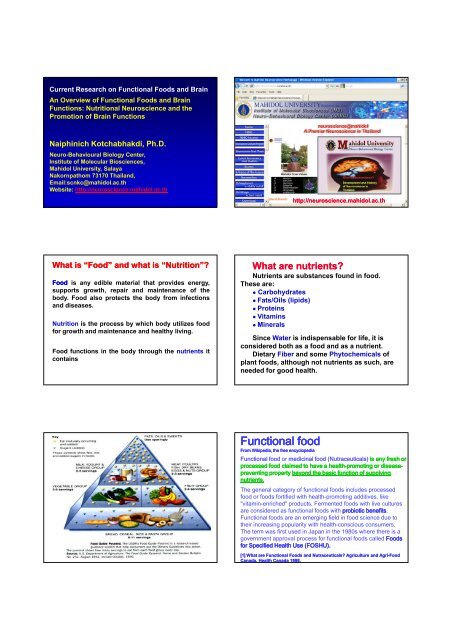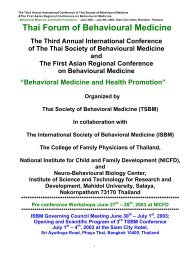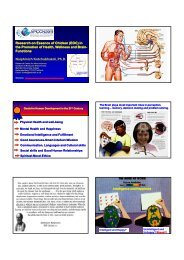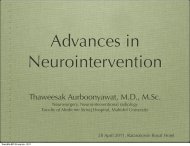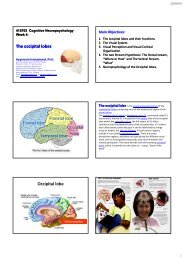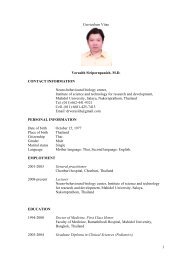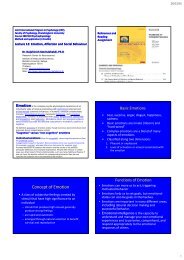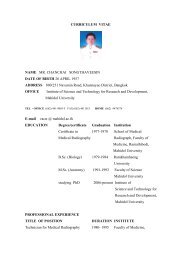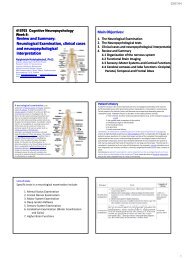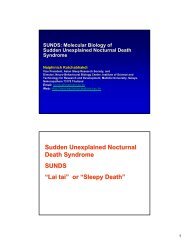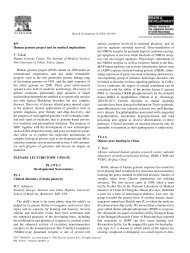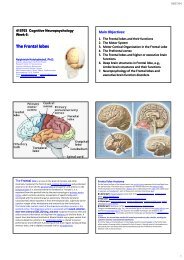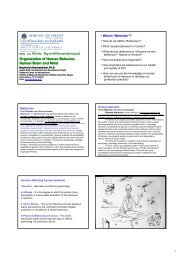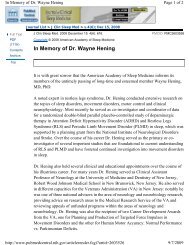Current Research on Functional Foods and Brain - Neuroscience ...
Current Research on Functional Foods and Brain - Neuroscience ...
Current Research on Functional Foods and Brain - Neuroscience ...
You also want an ePaper? Increase the reach of your titles
YUMPU automatically turns print PDFs into web optimized ePapers that Google loves.
<str<strong>on</strong>g>Current</str<strong>on</strong>g> <str<strong>on</strong>g>Research</str<strong>on</strong>g> <strong>on</strong> Functi<strong>on</strong>al <strong>Foods</strong> <strong>and</strong> <strong>Brain</strong>An Overview of Functi<strong>on</strong>al <strong>Foods</strong> <strong>and</strong> <strong>Brain</strong>Functi<strong>on</strong>s: Nutriti<strong>on</strong>al <strong>Neuroscience</strong> <strong>and</strong> thePromoti<strong>on</strong> of <strong>Brain</strong> Functi<strong>on</strong>sNaiphinich Kotchabhakdi, Ph.D.Neuro-Behavioural Biology Center,Institute of Molecular Biosciences,Mahidol University, SalayaNakornpathom 73170 Thail<strong>and</strong>,Email:scnkc@mahidol.ac.thWebsite: http://neuroscience.mahidol.ac.thhttp://neuroscience.mahidol.ac.thWhat is “Food” <strong>and</strong> what is “Nutriti<strong>on</strong>”?Food is any edible material that provides energy,supports growth, repair <strong>and</strong> maintenance of thebody. Food also protects the body from infecti<strong>on</strong>s<strong>and</strong> diseases.Nutriti<strong>on</strong> is the process by which body utilizes foodfor growth <strong>and</strong> maintenance <strong>and</strong> healthy living.Food functi<strong>on</strong>s in the body through the nutrients itc<strong>on</strong>tainsWhat are nutrients?Nutrients are substances found in food.These are:● Carbohydrates● Fats/Oils (lipids)● Proteins● Vitamins● MineralsSince Water is indispensable for life, it isc<strong>on</strong>sidered both as a food <strong>and</strong> as a nutrient.Dietary Fiber <strong>and</strong> some Phytochemicals ofplant foods, although not nutrients as such, areneeded for good health.Functi<strong>on</strong>al foodFrom Wikipedia, the free encyclopediaFuncti<strong>on</strong>al food or medicinal food (Nutraceuticals) is any fresh orprocessed food claimed to have a health-promoting or disease-preventing property bey<strong>on</strong>d the basic functi<strong>on</strong> of supplyingnutrients.The general category of functi<strong>on</strong>al foods includes processedfood or foods fortified with health-promoting additives, like"vitamin-enriched" products. Fermented foods with live culturesare c<strong>on</strong>sidered as functi<strong>on</strong>al foods with probiotic benefits.Functi<strong>on</strong>al foods are an emerging field in food science due totheir increasing popularity with health-c<strong>on</strong>scious c<strong>on</strong>sumers.The term was first used in Japan in the 1980s where there is agovernment approval process for functi<strong>on</strong>al foods called <strong>Foods</strong>for Specified Health Use (FOSHU).[1] What are Functi<strong>on</strong>al <strong>Foods</strong> <strong>and</strong> Nutraceuticals? Agriculture <strong>and</strong> Agri-FoodCanada, a, Health Canada 1998.
Scientific substantiati<strong>on</strong> for claims…(Article 6)1. Nutriti<strong>on</strong> <strong>and</strong> health claims shall be based <strong>on</strong><strong>and</strong> substantiated by generally acceptedscientific evidence.2. A food business operator making a nutriti<strong>on</strong> orhealth claim shall justify the use of the claim.3. The competent authorities of the Member Statesmay request a food business operator or apers<strong>on</strong> placing a product <strong>on</strong> the market toproduce all relevant elements <strong>and</strong> dataestablishing compliance with this Regulati<strong>on</strong>.Underst<strong>and</strong>ing brainfuncti<strong>on</strong>s in relati<strong>on</strong> to diet• Diet <strong>and</strong> cognitive functi<strong>on</strong>s• <strong>Brain</strong> c<strong>on</strong>diti<strong>on</strong>ing• Mood <strong>and</strong> optimal performance• Preventi<strong>on</strong> of cognitive decline• Food intake regulati<strong>on</strong> <strong>and</strong> hunger/satiety• Nutriti<strong>on</strong> <strong>and</strong> interorgan signalling - espgut-central nervous system interacti<strong>on</strong>Underst<strong>and</strong>ing dietary effects <strong>on</strong>immune <strong>and</strong> intestinal functi<strong>on</strong>• Modify systemic inflammatory activity bydiet• Dietary factors that t improve barrierfuncti<strong>on</strong>s• Biomarkers for intestinal health• Diet before <strong>and</strong> during pregnancy <strong>and</strong>lactati<strong>on</strong> - immunefuncti<strong>on</strong> <strong>and</strong> allergy• Improved allergome database for foods
Underst<strong>and</strong>ing the link between diet<strong>and</strong> metabolic functi<strong>on</strong> (obesity <strong>and</strong>associated metabolic disorders• Early biomarkers of metabolic syndrome• Individual variati<strong>on</strong>s in metabolic energy efficiency• Food comp<strong>on</strong>ents that regulate food intake <strong>and</strong>increase termogenesis• Interventi<strong>on</strong> strategies• Counteract age-associated associated muscle wasting• Low-grade inflammati<strong>on</strong> - obesity/insulinresistance/metabolic syndrome• Epigenetic events - chr<strong>on</strong>ic disease• Maternal <strong>and</strong> infant recommendati<strong>on</strong>s for opt health• Meal compositi<strong>on</strong> <strong>and</strong> size - energy uptake, satietyUnderst<strong>and</strong>ing c<strong>on</strong>sumer behaviourin relati<strong>on</strong> to health <strong>and</strong> nutriti<strong>on</strong>• Key determinants of food habits• Biological determinants in food choice• Methodology to underst<strong>and</strong> <strong>and</strong> quantifydeterminants• Percepti<strong>on</strong> <strong>and</strong> determinants of ”healthy lifestyle”• Better tools for effective communicati<strong>on</strong>• C<strong>on</strong>sumer knowledge - c<strong>on</strong>sumer underst<strong>and</strong>ingof health schemes, health claims, simplifiedlabelling - <strong>and</strong> pers<strong>on</strong>alised nutriti<strong>on</strong> based <strong>on</strong>nutrigenomicsThe integrated picturesocietal needs• Low health costs• Healthy ageingg• Improved educati<strong>on</strong> <strong>on</strong>healthy life style• Extend higher educati<strong>on</strong>programmes al<strong>on</strong>g foodhealthchain• Measures of trust• Improved communicati<strong>on</strong>about food <strong>and</strong> healthissues• Involve SMEs in food <strong>and</strong>health areac<strong>on</strong>sumers needs• Premium taste <strong>and</strong>pleasure• Low salt, low fat foods• Improved packaging• Pers<strong>on</strong>alised foods• Increased intestinal <strong>and</strong>b<strong>on</strong>e health• Improved immune <strong>and</strong>cognitive functi<strong>on</strong>s• Life style foods for eachlife cycle• Age-related diseasepreventi<strong>on</strong>science needs• Nutriti<strong>on</strong>al systems biology• New measures for foodintake <strong>and</strong> delivery systems• New imaging <strong>and</strong> minimallyinvasive techniques• Link databases <strong>and</strong>datamining of (n<strong>on</strong>) foodcomp<strong>on</strong>ents, intake <strong>and</strong>health parameters• Intestinal microbiotafuncti<strong>on</strong> <strong>and</strong> metagenomics• C<strong>on</strong>sumer preference,acceptance <strong>and</strong> needs
Some natural food <strong>and</strong> their active antioxidant comp<strong>on</strong>entSurh, Y-J, Nature Rev. Cancer 2003, 768GeneticNutriti<strong>on</strong>Envir<strong>on</strong>mentThe <strong>Brain</strong>Structural DevelopmentFuncti<strong>on</strong>al DevelopmentChemical DevelopmentEpigeneticProteomicReceptoromicGenomicTranscriptomicChannelomicMulti-omicapproachesBehavioural DevelopmentSynaptosomic
In developed countries, therehasbeenanexp<strong>on</strong>entialgrowth in the awareness of“Health”<strong>and</strong> “Functi<strong>on</strong>al”foods, healthful eating habit,mood <strong>and</strong> lifestyle.This isclearly shown by the rapidgrowthintheseareasofnutriti<strong>on</strong> <strong>and</strong>supplementaryfood industries, <strong>and</strong> billi<strong>on</strong>s ofdollarsspent worldwide<strong>on</strong>natural <strong>and</strong> functi<strong>on</strong>al foods,<strong>and</strong>food additives<strong>and</strong>supplements.The old expressi<strong>on</strong>, “We arewhat we eat” has becomemore familiar <strong>and</strong>, althoughsometime c<strong>on</strong>troversial,gaining str<strong>on</strong>ger scientificsupport.Recent progress of research in both fields ofNutriti<strong>on</strong> <strong>and</strong> <strong>Neuroscience</strong> has providedample of scientific evidence that variousspecific nutrients can influence <strong>and</strong> modifybrain <strong>and</strong>mentalfuncti<strong>on</strong>s.The informati<strong>on</strong> <strong>and</strong> knowledge gained in theseareas of scientific investigati<strong>on</strong> begins to havegreat impact in our future planning for human<strong>and</strong> social <strong>and</strong> ec<strong>on</strong>omic development.Furthermore,there havebeenincreasing number of reports <strong>on</strong> thedietarymodulati<strong>on</strong> ofanimal<strong>and</strong>human behaviours<strong>and</strong>/or mentalfuncti<strong>on</strong>sduring thelastdecade.Theseinclude, dietarysugar<strong>and</strong>hyperactivity in children, ameliorati<strong>on</strong>ofsymptomsof seas<strong>on</strong>alaffectivedisorder by dietary sugars, reducti<strong>on</strong>of mental stress <strong>and</strong> fatigue by theessence of chicken, improvement ofmental well-beingin elderly subjectsbydehydroepi<strong>and</strong>roster<strong>on</strong>ed d (DHEA)supplement, improvement of memoryfuncti<strong>on</strong>s by extract from the leave ofGingko biloba etc..In recent years, asurvey of the annual publicati<strong>on</strong>s <strong>on</strong>“Nutriti<strong>on</strong> <strong>and</strong> <strong>Brain</strong> Development <strong>and</strong>Functi<strong>on</strong>” yieldedover 500publicati<strong>on</strong>s, <strong>and</strong> since 1998 there is apeer-reviewedreviewed professi<strong>on</strong>al journal for“Nutriti<strong>on</strong>al<strong>Neuroscience</strong>”.Scientific American : April 1982Synaptic formati<strong>on</strong><strong>on</strong> the pyramidalcell in the cerebralcortex
Diets <strong>and</strong> Serot<strong>on</strong>in level
Scientific American: January 1986ตอนนี้การโฆษณาขายอาหารเสริมกันมาก โดยเฉพาะนํ้ามันปลา ซึ ่งพบว่ามีกรดไขมันที ่มีผลดีต่อพัฒนาการของสมอง กรดไขมันที ่ได้รับการกล่าวถึงมากคือ กรดไขมันในกลุ ่มโอเมก้า 6 ได้แก่linoleic acid ซึ ่งใช้ในการสร้าง Arachid<strong>on</strong>ic Acid และกรดไขมันในกลุ ่ม โอเมก้า 3(Omega-3) ได้แก่ linolenic acid หรือ Docosahexaenoic Acld (DHA) ซึ ่งกรดไขมันทั้งสองนี้ ้ ้ มีการสะสมมากในช่วงไตรมาสที่่สามของการตั้งครรภ์และในช่วง ้ ์ 18 เดือนหลังคลอดเพื ่อจะเป็ นส่วนประกอบของผนังเซลล์ของระบบประสาทในนมแม่มีสาร DHA ซึ ่งพบว่ามีส่วนช่วยในการเจริญเติบโตของสมองที ่เกี ่ยวกับการมองเห็นด้วยกรดไขมันสองตัวนี้มีมากในปลา เช่น ปลาทู ปลากระพง การกินอาหารปลาจากธรรมชาติอย่างเพียงพอจะช่วยให้ร่างกายได้รับกรดไขมันในปริมาณเพียงพอกับความต้องการของร่างกายด้วยไม่จําเป็ นต้องซื้อนํ้ามันปลาสําเร็จรูปมากินอีกEssential fatty acidThe term “essential” meansthat the fatty acids can not besynthesized in the body in an amountsufficient to meet the physiologicalneeds , must be supplied by way ofdiet
Visual Acuity Assesment in InfantBehavioral measurement FORCED CHOICE PREFERENTIALLOOKINGForced Choice Preferential LookingProcessing/Integrati<strong>on</strong>Behavioralresp<strong>on</strong>seRetinaVisualCortexVisualStimulusDocosahexaenoic acid (DHA) is <strong>on</strong>e of themajor compositi<strong>on</strong>s of membranephospholipids in mammalian central nervoussystemVisual Acuity Assesment in InfantElectrophysiologicmeasurementSweep Visual Evoked PotentialEEG/VEPresp<strong>on</strong>se VisualCortexSweep VEPLog MAR1.210.8C<strong>on</strong>trol FDHA1.4 Behavioral measurementFPL acuity10.80.6DHA+AAHMElectrophysiologicmeasurementSweep VEP acuityVisualStimulusRetina0.60.40.20.40.206 wks 17 5206 wks 17 520.80.60.40.20.32LCPUFA effect <strong>on</strong> visual acuity of Terminfants by age of Behavioral evaluati<strong>on</strong>* * *0.49Formula+DHA vs FBF vs Formula0.18 04 0.4LCPUFA effect <strong>on</strong> visual acuity of Terminfants by age of VEP evaluati<strong>on</strong>1.2 Formula+ DHA vs F * 1.16* 1.03D AcuityBF vs Formula(octaves)0.8*0.370-0.2-0.4* p
Visual Acuity Relative Resp<strong>on</strong>se in relati<strong>on</strong> to DHA in For1,8(experimental/c<strong>on</strong>trol1,61,41,210,80,6Number of studies = 12Number of subjects = 539y = 1,1014x + 0,7896R 2 = 0,30180 0,1 0,2 0,3 0,4DHA (% total fatty acids )Visual Acuity Relative Resp<strong>on</strong>se in relati<strong>on</strong> to DHA Eq in F1,81,61,41,210,80,6y = 3E-05x 2 - 0,0026x + 0,9491R 2 = 0,82740 50 100 150 200 250DHA Equivalents (mg per day ) 10 % c<strong>on</strong>versi<strong>on</strong> LNA1,81,61,41,20,80,6Visual Acuity Relative Resp<strong>on</strong>se in relati<strong>on</strong> to DHA Eq in Fo1y = 3E-05x 2 - 0,0032x + 1,0371R 2 = 0,75870 50 100 150 200 250DHA Equivalents (mg per day ) 5 % c<strong>on</strong>versi<strong>on</strong> LNA toVisual Acuity Relative Resp<strong>on</strong>se in relati<strong>on</strong> to DHA Eq in Fo1,8y = 3E-05x 2 - 0,0028x + 1,02241,6R 2 = 0,73871,41,210,80,60 50 100 150 200 250DHA Equivalents (mg per day ) 1 % c<strong>on</strong>versi<strong>on</strong> LNA toLTPResultL<strong>on</strong>g-termPotentiati<strong>on</strong> inHippocampus
<strong>Brain</strong> Aging is a multiphase processBlueberry
Antioxidant Diets ImproveCognitive Functi<strong>on</strong>Table 1. Antioxidant interventi<strong>on</strong>s improve cognitive functi<strong>on</strong>.Durati<strong>on</strong> ofRef # Antioxidant Subjects Study Cogniti<strong>on</strong>[112] PBN gerbils 14 days improved spatial memory in radial arm maze[113] Blueberry, spinach 19 m<strong>on</strong>th old rats 8 weeks improved <strong>on</strong>e-trial learning in the water maze&strawberryimproved vitaminElevels inthe hippocampus[114] PBN 24 m<strong>on</strong>th old rats 4-5 m<strong>on</strong>ths improved memory retenti<strong>on</strong> <strong>on</strong> spatial memory taskvitamin Eimproved learning of a spatial memory task[115] Strawberry, spinach 6 m<strong>on</strong>th old rats 8 m<strong>on</strong>ths enhanced retenti<strong>on</strong> in a spatial water maze taskAnd vitamin E[116] PBN 24 m<strong>on</strong>th old rats 9.5 m<strong>on</strong>ths improved memory <strong>and</strong> learning <strong>on</strong> spatial memory taskfaster acquisiti<strong>on</strong> of a <strong>on</strong>e-way activate avoidance task[117] PBN senescence 12 m<strong>on</strong>ths significantly lengthened life spanaccelerated mice[118] Vitamin E Rats receiving 7 days reduced spatial memory impairments induced by Aintraventricular A[119] Vitamin E AD 2 years significantly delayed instituti<strong>on</strong>alizati<strong>on</strong>Error r Scores250200150100500n=12C<strong>on</strong>trolC<strong>on</strong>trolAoxn=13DietC<strong>on</strong>troln=6C<strong>on</strong>trol Aoxn=7DietYoungAgedA diet rich in antioxidantsimproves l<strong>and</strong>markdiscriminati<strong>on</strong> learning inoldbut not young dogs(p
<str<strong>on</strong>g>Research</str<strong>on</strong>g> <strong>on</strong> the Essence of Chicken:Resp<strong>on</strong>ses of Human <strong>Brain</strong> Electrical Activities toDrinking of Essence of ChickenDeclarati<strong>on</strong> of C<strong>on</strong>flict of Interest:Naiphinich Kotchabhakdi, Chittin Chindadoungratana,<strong>and</strong> William G.A. L<strong>on</strong>gworthNeuro-Behavioural Biology Center,Institute of Science <strong>and</strong> Technology for <str<strong>on</strong>g>Research</str<strong>on</strong>g><strong>and</strong> Development, Mahidol University, Salaya,Nakornpathom 73170 Thail<strong>and</strong>.Email: scnkc@mahidol.ac.thThe following research work wassupported by a research grant from:Cerebos (Thail<strong>and</strong>) Ltd.AndCerebos Pacific Ltd.Copyright 2000 by N.Kotchabhakdi et al & Mahidol-Cerebos Collaborative <str<strong>on</strong>g>Research</str<strong>on</strong>g> ProjectBRAND’S Essence of Chicken (BEC)have been widely c<strong>on</strong>sumed, particularly in Chinesecommunities in Southeast Asia, as traditi<strong>on</strong>al remedies<strong>and</strong> promoti<strong>on</strong> for several ailments. It was also known tobe beneficial in various c<strong>on</strong>diti<strong>on</strong>s including:(A) Physical recovery from <strong>and</strong> nutriti<strong>on</strong>al supplement forthe sickness that often occurs in elderly <strong>and</strong> postpartumwomen;(B) the physical development of athletes;(C) recovery from physical <strong>and</strong> mental Stress; <strong>and</strong>(D) stimulating <strong>and</strong> enhancing mental efficiency ofstudents.Several scientific studies have been c<strong>on</strong>ducted over theyears to uncover the benefits of c<strong>on</strong>suming BEC.In 1987, , research c<strong>on</strong>ducted by leadingnutriti<strong>on</strong>ists at King’s College in L<strong>on</strong>d<strong>on</strong>dem<strong>on</strong>strated that 2 types of BEC substantiallyincrease mean metabolic rate by an average 8%<strong>and</strong> 12 % of above fasting baseline valuescompared to 2% % <strong>and</strong> 4% % increase with water orplacebo. The resp<strong>on</strong>se was greater thanexpected from the total energy <strong>and</strong> proteinc<strong>on</strong>tent of the essence, <strong>and</strong> sustained l<strong>on</strong>gerthan three hours after c<strong>on</strong>sumpti<strong>on</strong> of BEC. Itwas c<strong>on</strong>cluded that the acute metabolicresp<strong>on</strong>se may be due to the effects of particularamino acid compositi<strong>on</strong>, or other specificcomp<strong>on</strong>ents <strong>and</strong>/or a cephalic (brain) resp<strong>on</strong>seto taste.
Metabolic rateThermic effects of BECGeissler C et al Nutriti<strong>on</strong> Reports Internati<strong>on</strong>al March 1989 Vol. 39 No. 3What are in BEC?BEC(Essence of Chicken)Protein c<strong>on</strong>tent (%) 7.58Amino Acids (mg/100gm)Aspartic acid 387.63Thre<strong>on</strong>ine 163.85Serine 175.04Glutamic acid 848.64Proline 497.25Glycine 938.10Alanine 544.27Cystinen<strong>on</strong>-detect.Valine 162.01Methi<strong>on</strong>ine 84.78Isoleucine 125.04Leucine 269.19Tyrosine 47.24Phenylalanine 382.77Histidine 219.24Lysine 319.68Arginine 402.48Tryptophan 14.83Copyright 2000 by N.Kotchabhakdi et al & Mahidol-Cerebos Collaborative <str<strong>on</strong>g>Research</str<strong>on</strong>g> ProjectCONTENT: 274 mg/100gm68.6 mg/100gmTaurine: 53 mg/100gm
In PlasmaIn Cerebral CortexIn HippocampusIn Hypothalamus
<str<strong>on</strong>g>Research</str<strong>on</strong>g> <strong>on</strong> the effects of Essence of Chickenby the Neuro-Behavioural Biology Center, Mahidol University, Salaya.We completed a clinical study <strong>on</strong> two groups of subjects.The first group of the Pilot study c<strong>on</strong>sisted of 15healthy volunteers university students who drank 2 bottlesof 70 ml., <strong>and</strong> we m<strong>on</strong>itored the effects <strong>on</strong> brain electricalactivities (Electroencephalogram or EEG) 2 hours before,<strong>and</strong> 4 hours after drinking.The sec<strong>on</strong>d group of 50 subjects followed theR<strong>and</strong>omized double-blind, blind, placebo-c<strong>on</strong>trolc<strong>on</strong>trol <strong>and</strong> crossoverstudy design. In the sec<strong>on</strong>d group, data werecollected <strong>on</strong> the first day <strong>and</strong> after seven days of drinking 2bottles of either BEC or placebo daily.Copyright 2000 by N.Kotchabhakdi et al & Mahidol-Cerebos Collaborative <str<strong>on</strong>g>Research</str<strong>on</strong>g> Projectการศึกษานําร่อง (Pilot Study)Drinking BEC<strong>on</strong>e 70 cc. Bottle,2, or 3 BottlesC<strong>on</strong>tinuous Recording of EEGEC EO EC EO EC EO EC EO EC EOGroup AR<strong>and</strong>omized Double-blind,Placebo-C<strong>on</strong>trol withCross-over Study1st Day 7th Day 1st Day 7th Day1 HourBeforeEC = Eye Closed1 Hour 2 Hour 3 Hour 4 HourAfterEO = Eye OpenedDaily DrinkingBEC70 cc. X 23weeksBreakData Collecti<strong>on</strong> fromvolunteer subjectsDaily DrinkingPlacebo70 cc. X 2R<strong>and</strong>omized Double-blind,Placebo-C<strong>on</strong>trol withCross-over StudyGroup B1st Day 7th Day 1st Day 7th DayDaily DrinkingPlacebo70 cc. X 23weeksBreakData Collecti<strong>on</strong> fromvolunteer subjectsDaily DrinkingBEC70 cc. X 2Copyright 2000 by N.Kotchabhakdi et al & Mahidol-Cerebos Collaborative <str<strong>on</strong>g>Research</str<strong>on</strong>g> Project
BEC(Essence of Chicken)(Collagen)Protein c<strong>on</strong>tent (%) 7.58 6.98Amino Acids (mg/100gm)Aspartic acid 387.63 332.32Thre<strong>on</strong>ine 163.85 119.68Serine 175.04 195.26Glutamic acid 848.64 678.13Proline 497.25 811.83Glycine 938.10 1,676.68Alanine 544.27 650.97Cystine n<strong>on</strong>-detect. n<strong>on</strong>-detect.Valine 162.01 144.77Methi<strong>on</strong>ine 84.78 35.07Isoleucine 125.04 87.15Leucine 269.19 180.35Tyrosine 47.24 18.98Phenylalanine 382.77 110.67Histidine 219.24 46.71Lysine 319.68 222.26Arginine 402.48 493.34Tryptophan 14.83 0.84Copyright 2000 by N.Kotchabhakdi et al & Mahidol-Cerebos Collaborative <str<strong>on</strong>g>Research</str<strong>on</strong>g> ProjectPlaceboPlaceboBEC(Essence of Chicken)(Collagen)L-Carnosine (mg/100ml) 73.0 n<strong>on</strong>-detectL-Anserine (mg/100ml) 302.0 n<strong>on</strong>-detectTaurine 53.0 n<strong>on</strong>-detectCopyright 2000 by N.Kotchabhakdi et al & Mahidol-Cerebos Collaborative <str<strong>on</strong>g>Research</str<strong>on</strong>g> ProjectDoes the subject feel anythingsubjectively after daily drinkingBEC?Subjective rating scale by visualanalog scale.14 itemsCompare BEC with placeboSubjective rating scale by visual analog scale:1. Physical strength <strong>and</strong> vigor2. Refreshing3. Stress-tensi<strong>on</strong>tensi<strong>on</strong>-anxiety4. Depressi<strong>on</strong>5. Fatigue6. C<strong>on</strong>fusi<strong>on</strong>7. C<strong>on</strong>centrati<strong>on</strong>8. Drowsiness9. Alert10. Happiness11. Friendliness12. Pain <strong>and</strong> headache13. Sleep14. Better feeling compare to yesterday
All items were P < 0.05; N =5050 Copyright 2000 by N.Kotchabhakdi et al & Mahidol-Cerebos Collaborative <str<strong>on</strong>g>Research</str<strong>on</strong>g> ProjectInternati<strong>on</strong>al 10-20 Electrode Placement SystemCopyright 2000 by N.Kotchabhakdi et al & Mahidol-Cerebos Collaborative <str<strong>on</strong>g>Research</str<strong>on</strong>g> ProjectEEG Signal Recorded:EEG is the summati<strong>on</strong> of the c<strong>on</strong>tinuously-varyingbio-electrical activity of multiple neur<strong>on</strong>al ‘dipole’populati<strong>on</strong>s beneath the electrodes, <strong>and</strong> can bec<strong>on</strong>sidered a composite waveform, comprised ofindividual comp<strong>on</strong>ents of various clinically usefulfrequencies:--- Delta (0.0 - 3.5Hz)--- Theta (4.0 - 7.5Hz)--- Alpha (8.0 - 13.0Hz)--- Beta (>13Hz)Copyright 2000 by N.Kotchabhakdi et al & Mahidol-Cerebos Collaborative <str<strong>on</strong>g>Research</str<strong>on</strong>g> Project
EYE OpenedCopyright 2000 by N.Kotchabhakdi et al & Mahidol-Cerebos Collaborative <str<strong>on</strong>g>Research</str<strong>on</strong>g> ProjectEye ClosedCopyright 2000 by N.Kotchabhakdi et al & Mahidol-Cerebos Collaborative <str<strong>on</strong>g>Research</str<strong>on</strong>g> ProjectTopographic <strong>Brain</strong> MappingCopyright 2000 by N.Kotchabhakdi et al & Mahidol-Cerebos Collaborative <str<strong>on</strong>g>Research</str<strong>on</strong>g> ProjectCopyright 2000 by N.Kotchabhakdi et al & Mahidol-Cerebos Collaborative <str<strong>on</strong>g>Research</str<strong>on</strong>g> ProjectCopyright 2000 by N.Kotchabhakdi et al & Mahidol-Cerebos Collaborative <str<strong>on</strong>g>Research</str<strong>on</strong>g> ProjectEyes-closed EEG sample taken 50 mins prior to BEC ingesti<strong>on</strong>.Copyright 2000 by N.Kotchabhakdi et al & Mahidol-Cerebos Collaborative <str<strong>on</strong>g>Research</str<strong>on</strong>g> Project
Eyes-closed EEG sample taken at the time of BEC ingesti<strong>on</strong>.Copyright 2000 by N.Kotchabhakdi et al & Mahidol-Cerebos Collaborative <str<strong>on</strong>g>Research</str<strong>on</strong>g> ProjectEyes-closed EEG sample taken 50 mins following BEC ingesti<strong>on</strong>.Copyright 2000 by N.Kotchabhakdi et al & Mahidol-Cerebos Collaborative <str<strong>on</strong>g>Research</str<strong>on</strong>g> ProjectEyes-closed EEG sample taken 2-1/2 hrs following BEC ingesti<strong>on</strong>.Copyright 2000 by N.Kotchabhakdi et al & Mahidol-Cerebos Collaborative <str<strong>on</strong>g>Research</str<strong>on</strong>g> ProjectCopyright 2000 by N.Kotchabhakdi et al & Mahidol-Cerebos <str<strong>on</strong>g>Research</str<strong>on</strong>g> ProjecCopyright 2000 by N.Kotchabhakdi et al & Mahidol-Cerebos <str<strong>on</strong>g>Research</str<strong>on</strong>g> Project160.0140.0120.0100.080.060.040.020.00.0BEC-03 P3 Site EC-CARAbsolute Power ValuesCHICKEN SOUP #1 DATADelta Theta Alpha Beta TotalCopyright 2000 by N.Kotchabhakdi et al & Mahidol-Cerebos Collaborative <str<strong>on</strong>g>Research</str<strong>on</strong>g> Project-60-50-40-30-20-100102030405060708090100110120130140150160170180190200210
180.0160.0140.0120.0100.080.060.040.020.00.0BEC-03 P4 Site EC-CARAbsolute Power ValuesCHICKEN SOUP #1 DATADelta Theta Alpha Beta TotalCopyright 2000 by N.Kotchabhakdi et al & Mahidol-Cerebos Collaborative <str<strong>on</strong>g>Research</str<strong>on</strong>g> Project-60-50-40-30-20-100102030405060708090100110120130140150160170180190200210The effects of BEC <strong>on</strong> EEG power SpectraGroup data (N = 48)Electrodes: F3, F4, C3, C4, P3, P4Link to m<strong>and</strong>ible groundsTime series analysis:Periods During Eye Opened(EO) During Eye Closed (EC)1. -85 min. (before BEC ingesti<strong>on</strong>) -75 min.2. +5 min. (after BEC ingesti<strong>on</strong>) +10 min.3. +25 min. +30 min.4. +45 min. +50 min.5. +65 min. +70 min.6. +115 min. +120 min.7. +165 min. +170 min.Data from Day <strong>on</strong>e compare with Day SevenCopyright 2000 by N.Kotchabhakdi et al & Mahidol-Cerebos Collaborative <str<strong>on</strong>g>Research</str<strong>on</strong>g> ProjectCopyright 2000 by N.Kotchabhakdi et al & Mahidol-Cerebos Collaborative <str<strong>on</strong>g>Research</str<strong>on</strong>g> Project20.0Day 1 Data: BEC minus PlaceboAbsolute Power Percent-Change Relative Difference: P3 site E/O LMRPositive numbers = BEC increased power > Placebo OR decreased power < PlaceboNegative numbers = Placebo increased power > BEC OR decreased power < BEC20.0Copyright 2000 by N.Kotchabhakdi et al & Mahidol-Cerebos Collaborative <str<strong>on</strong>g>Research</str<strong>on</strong>g> ProjectDay 1 Data: BEC minus PlaceboAbsolute Power Percent-Change Relative Difference: P4 site E/O LMRPositive numbers = BEC increased power > Placebo OR decreased power < PlaceboNegative numbers = Placebo increased power > BEC OR decreased power < BEC15.015.0ive Difference10.05.0ive Difference10.05.0Percent-Change Relati0.0-5.0-10.0Percent-Change Relati0.0-5.0-10.0-15.0-15.0-20.0Delta Theta Alpha Beta Total-20.0Delta Theta Alpha Beta TotalFrequency B<strong>and</strong>Frequency B<strong>and</strong>A bsolute PowerPercent-chang e ACopyright 2000 by N.Kotchabhakdi et al & Mahidol-Cerebos Collaborative <str<strong>on</strong>g>Research</str<strong>on</strong>g> Project230.0220.0210.0200.0190.0180.0170.0160.0150.0140.0130.0120.0110.0100.090.080.0BEC - 2 bottles: Delta, Theta, Alpha, Beta <strong>and</strong> TotalFrequency Range activity from left parietal (P3) site (E/C, LMR)*** P < 0.0010 20 40 60 80 100 120 140 160 180 200Time post-ingesti<strong>on</strong> (in minutes)Delta Theta Alpha Beta Total Geissler C et al Nutriti<strong>on</strong> Reports Internati<strong>on</strong>al March 1989 Vol. 39 No. 3
Copyright 2000 by N.Kotchabhakdi et al & Mahidol-Cerebos Collaborative <str<strong>on</strong>g>Research</str<strong>on</strong>g> ProjectAbsolute PowerPercent-chang e in230.0220.0210.0200.0190.0180.0170.0160.0150.0140.0130.0120.0110.0100.090.0Comparis<strong>on</strong> of BEC: 1 vs 2 bottles:Alpha activity from parietal electrodes (E/C, LMR)*** P < 0.001BEC-1 P3BEC-2 P3BEC-1 P4BEC-2 P480.00 20 40 60 80 100 120 140 160 180 200Time post-ingesti<strong>on</strong> (in minutes)Effects of Drinking of the Essence of Chicken<strong>on</strong> the Event-Related Potentials (P300)Copyright 2000 by N.Kotchabhakdi et al & Mahidol-Cerebos Collaborative <str<strong>on</strong>g>Research</str<strong>on</strong>g> ProjectCopyright 2000 by N.Kotchabhakdi et al & Mahidol-Cerebos Collaborative <str<strong>on</strong>g>Research</str<strong>on</strong>g> ProjectCopyright 2000 by N.Kotchabhakdi et al & Mahidol-Cerebos Collaborative <str<strong>on</strong>g>Research</str<strong>on</strong>g> ProjectA representative sample (<strong>on</strong>e subject)showing the differential effects of BEC<strong>and</strong> Placebo substances <strong>on</strong> AuditoryP300 ERP latencies.From the beginning of the dosing cycle(Day 1, pre-ingesti<strong>on</strong>) to the end (Day 7,post-ingesti<strong>on</strong>), BEC tended to result ina shortening of the ‘P300‘ comp<strong>on</strong>entlatency, whereas Placebo resulted in aprol<strong>on</strong>gati<strong>on</strong> of same: opposite effects.Copyright 2000 by N.Kotchabhakdi et al & Mahidol-Cerebos Collaborative <str<strong>on</strong>g>Research</str<strong>on</strong>g> ProjectCopyright 2000 by N.Kotchabhakdi et al & Mahidol-Cerebos Collaborative <str<strong>on</strong>g>Research</str<strong>on</strong>g> Project
BEC Subject #04Substance: BECTesting Day: 1Pre-ingesti<strong>on</strong> Auditory P300 ERPP300 Latency: 304 msCopyright 2000 by N.Kotchabhakdi et al & Mahidol-Cerebos Collaborative <str<strong>on</strong>g>Research</str<strong>on</strong>g> ProjectCopyright 2000 by N.Kotchabhakdi et al & Mahidol-Cerebos Collaborative <str<strong>on</strong>g>Research</str<strong>on</strong>g> ProjectBEC Subject #04Substance: BECTesting Day: 7Post-ingesti<strong>on</strong> Auditory P300 ERPP300 Latency: 290 msCopyright 2000 by N.Kotchabhakdi et al & Mahidol-Cerebos Collaborative <str<strong>on</strong>g>Research</str<strong>on</strong>g> ProjectCopyright 2000 by N.Kotchabhakdi et al & Mahidol-Cerebos Collaborative <str<strong>on</strong>g>Research</str<strong>on</strong>g> ProjectBEC Subject #04Substance: PlaceboTesting Day: 1Pre-ingesti<strong>on</strong> Auditory P300 ERPP300 Latency: 280 msCopyright 2000 by N.Kotchabhakdi et al & Mahidol-Cerebos Collaborative <str<strong>on</strong>g>Research</str<strong>on</strong>g> ProjectCopyright 2000 by N.Kotchabhakdi et al & Mahidol-Cerebos Collaborative <str<strong>on</strong>g>Research</str<strong>on</strong>g> Project
BEC Subject #04Substance: PlaceboTesting Day: 7Post-ingesti<strong>on</strong> Auditory P300 ERPP300 Latency: 304 msCopyright 2000 by N.Kotchabhakdi et al & Mahidol-Cerebos Collaborative <str<strong>on</strong>g>Research</str<strong>on</strong>g> ProjectCopyright 2000 by N.Kotchabhakdi et al & Mahidol-Cerebos Collaborative <str<strong>on</strong>g>Research</str<strong>on</strong>g> Project340P300 Latency Comparis<strong>on</strong> (Total Group n=45-49)between BEC <strong>and</strong> Placebo, <strong>and</strong> between Testing Days 1 <strong>and</strong> 7340P300 Latency Comparis<strong>on</strong> (Total Group n=43-49)between BEC <strong>and</strong> Placebo, <strong>and</strong> between Testing Days 1 <strong>and</strong> 7330330y (msec's)P300 Latency320310300290e ncy (mse c)P300 Late320310300290280BEC Day 1 Pre-ingesti<strong>on</strong> (n=49) BEC Day 7 Post-ingesti<strong>on</strong> (n=48) Placebo Day 1 Pre-ingesti<strong>on</strong>(n=46)P < 0.0505Placebo Day 7 Post-ingesti<strong>on</strong>(n=45)280BEC Day 1Preingesti<strong>on</strong>(n=49)BEC Day 1Postingesti<strong>on</strong>(n=47)BEC Day 7Preingesti<strong>on</strong>(n=47)BEC Day 7Postingesti<strong>on</strong>(n=48)Placebo PlaceboDay 1 Preingestioingesti<strong>on</strong>Day 1 Post-(n=46) (n=45)Placebo PlaceboDay 7 Preingestioingesti<strong>on</strong>Day 7 Post-(n=43) (n=45)26Digit Span: Chicken SoupEffects of Drinking of the Essence of Chicken<strong>on</strong> Horm<strong>on</strong>al Levels in Normal Human Volunteers24oreSc222018prepostChittin Chindadoungratana, Naiphinich Kotchabhakdi,<strong>and</strong> William G.A. L<strong>on</strong>gworth161412Neuro-Behavioural Biology Center,Institute of Science <strong>and</strong> Technology for <str<strong>on</strong>g>Research</str<strong>on</strong>g><strong>and</strong> Development, Mahidol University, Salaya,Nakornpathom 73170 Thail<strong>and</strong>.10day1Day Samplingday7Email: scnkc@mahidol.ac.thCopyright 2000 by N.Kotchabhakdi et al & Mahidol-Cerebos Collaborative <str<strong>on</strong>g>Research</str<strong>on</strong>g> Project
CORTISOL25.01 st DAY BRANDWe completed the clinical study <strong>on</strong> the effects of Essence of Chicken(EC)<strong>on</strong> the level of serum cortisol. The subjects c<strong>on</strong>sisted of 40healthy male volunteers from university students who drank 2 bottlesof 70 ml. of the Essence of Chicken (EC). We m<strong>on</strong>itored the level ofserum cortisol, <strong>and</strong> prolactin <strong>on</strong> day <strong>on</strong>e <strong>and</strong> day seven after 7 days ofEC by radio-immuno-assay (RIA) technique before <strong>and</strong> 1, 2, <strong>and</strong> 3hours after c<strong>on</strong>sumpti<strong>on</strong> of EC. The samegroupalso tested with ih aplacebo, which composed of protein soluti<strong>on</strong> from collagen in adouble-blind placebo-c<strong>on</strong>trol study design. Our data showed that afterdrinking 2 bottles of BEC, there were extremely significant decreasesin the level of serum cortisol while there were no significant changesin the group that c<strong>on</strong>sumed placebo. In our study, serum prolactin didnot change significantly. The levels of the serum cortisol have beenwidely used as indicators of the levels of physical <strong>and</strong>/orpsychological stresses <strong>and</strong> anxiety. The data provide solid evidencethat BEC produce a relaxati<strong>on</strong> <strong>and</strong> recovery from stress <strong>and</strong> anxiety.Cortiso ol (mcg %)20.015.010.05.00.0Sampling Series*** P < 0.001Pre-ingesti<strong>on</strong> Br<strong>and</strong>1 hr Post-Ingesti<strong>on</strong>2 hrs Post-Ingesti<strong>on</strong>3 hrs Post-Ingesti<strong>on</strong>Copyright 2000 by N.Kotchabhakdi et al & Mahidol-Cerebos Collaborative <str<strong>on</strong>g>Research</str<strong>on</strong>g> ProjectCopyright 2000 by N.Kotchabhakdi et al & Mahidol-Cerebos Collaborative <str<strong>on</strong>g>Research</str<strong>on</strong>g> Project
Cortisol (mcg %)7th DAY BRAND16.014.012.0*** P < 0.00110.08.06.04.02.00.0Sampling SeriesCopyright 2000 by N.Kotchabhakdi et al & Mahidol-Cerebos Collaborative <str<strong>on</strong>g>Research</str<strong>on</strong>g> ProjectPre-Ingesti<strong>on</strong>1 hr Post-Ingesti<strong>on</strong>2 hrs Post-Ingesti<strong>on</strong>3 hrs Post-Ingesti<strong>on</strong>Corti sol (mcg %)16.014.012.010.08.06.04.02.00.01 st Day PlaceboN.S.Sampling SeriesCopyright 2000 by N.Kotchabhakdi et al & Mahidol-Cerebos Collaborative <str<strong>on</strong>g>Research</str<strong>on</strong>g> ProjectPre-Ingestii<strong>on</strong>1 hr Post-Ingesti<strong>on</strong>2 hrs Post-Ingesti<strong>on</strong>3 hrs Post-Ingesti<strong>on</strong>16.07 th Day Placebo14Cortisol (mcg %)14.012.0* P < 0.0110.0Pre-Ingesti<strong>on</strong>1 hr Post-Ingesti<strong>on</strong>8.02 hrs Post-Ingesti<strong>on</strong>6.03 hrs Post-Ingesti<strong>on</strong>4.02.00.0Sampling SeriesCopyright 2000 by N.Kotchabhakdi et al & Mahidol-Cerebos Collaborative <str<strong>on</strong>g>Research</str<strong>on</strong>g> ProjectCortisol (mcg % )121086420** P < 0.01 N.S.1st Day Ingesti<strong>on</strong>7th Day Ingesti<strong>on</strong>Br<strong>and</strong>BECPlaceboPlaceboCopyright 2000 by N.Kotchabhakdi et al & Mahidol-Cerebos Collaborative <str<strong>on</strong>g>Research</str<strong>on</strong>g> ProjectCONTENT: 274 mg/100gm68.6 mg/100gmAll items were P < 0.0505Taurine: 53 mg/100gm
CONCLUSION:Effects BEC <strong>on</strong> <strong>Brain</strong> Functi<strong>on</strong>sThe data from both groups show significant changes of the EEG. The alpha waves(8-13 Hz.) significantly increased <strong>and</strong> become more synchr<strong>on</strong>ized during bot theeye-closed <strong>and</strong> eye-opened periods over durati<strong>on</strong> of 3 hours as compared to thec<strong>on</strong>trol period before drinking <strong>and</strong> after c<strong>on</strong>sumpti<strong>on</strong> of the placebo. The betawaves (>13 Hz.), <strong>on</strong> the other h<strong>and</strong>, significantly increased during the eye-openedthere seemed to be no statistically significant changes in the delta (0-3 Hz.) <strong>and</strong>theta (4-7 Hz.) wavesThe increase in alpha waves <strong>and</strong> synchr<strong>on</strong>y is well known to occur during variouspractice of mental relaxati<strong>on</strong> <strong>and</strong> meditati<strong>on</strong> which allow the subject a betterability to c<strong>on</strong>centrate <strong>and</strong> organize their mental thinking processes. The increaseof beta wave during eye-opened period also indicated that BEC can enhancearousal state <strong>and</strong> alertness..These findings provide clear evidence that BEC can significantly <strong>and</strong> specificallyimprove brain functi<strong>on</strong>s since an increase in alpha wave activities during eyeclosedperiod can be interpreted as evidence that BEC produces a desirable stateof brain relaxati<strong>on</strong> <strong>and</strong> reducti<strong>on</strong> of stress <strong>and</strong> anxiety. The fact that there were nosignificant changes in the delta <strong>and</strong> the theta waves after drinking BEC indicatedthat BEC did not produce drowsiness or day-dreaming. Hence, the finding can beuse to support that BEC produces an increase in efficiency of brain functi<strong>on</strong>s, <strong>and</strong>also correlated to findings in psychological studies which show improvement ofalertness, attenti<strong>on</strong>, <strong>and</strong> subjective feeling of reduced stress <strong>and</strong> anxiety.Copyright 2000 by N.Kotchabhakdi et al & Mahidol-Cerebos Collaborative <str<strong>on</strong>g>Research</str<strong>on</strong>g> Project


